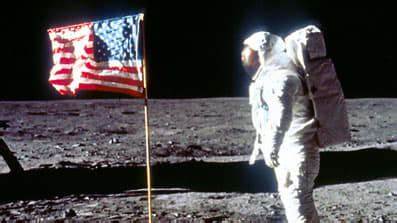(单词翻译:单击)
听力文本
The attempt failed. The target satellite exploded as it separated from its main rocket. America's space agency decided to move forward. It would launch the next in its Gemini series. Then someone had an idea: why not launch both Geminis. The second one could chase the first one, instead of a satellite. Again, things did not go as planned. It took two tries to launch the second Gemini. By that time, the first one had been in orbit about eleven days. Time was running out. The astronauts on the second Gemini moved their spacecraft into higher orbits. They got closer and closer to the Gemini ahead of them. They needed to get within six hundred meters to be considered successful.
After all the problems on the ground, the events in space went smoothly. The two spacecraft got within one-third of a meter of each other. The astronauts had made the operation seem easy. In January, nineteen fifty-nine, the Soviets launched a series of unmanned Luna rockets. The third of these flights took pictures of the far side of the moon. This was the side no one on Earth had ever seen. The United States planned to explore the moon with its unmanned Ranger spacecraft. There were a number of failures before Ranger 7 took pictures of the moon. These pictures were made from a distance. The world did not get pictures from the surface of the moon until the Soviet Luna 9 landed there in February, nineteen sixty-six. For the next few years, both the United States and Soviet Union continued their exploration of the moon. Yet the question remained: which one would be the first to put a man there. In December, nineteen sixty-eight, the United States launched Apollo 8 with three astronauts. The flight proved that a spacecraft could orbit the moon and return to Earth safely.
The Apollo 9 spacecraft had two vehicles. One was the command module. It could orbit the moon, but could not land on it. The other was the Lunar module. On a flight to the moon, it would separate from the command module and land on the moon's surface. Apollo 10 astronauts unlinked the Lunar module and flew it close to the moon's surface. After those flights, everything was ready. "Twelve, eleven, ten, nine ... ignition sequence start ... six, five, four, three, two, one, zero. All engines running. Lift-off. We have a lift-off. Thirty-two minutes past the hour. Lift-off of Apollo 11." On July sixteenth, nineteen sixty-nine, three American astronauts lifted off in Apollo 11. On the twentieth, Neil Armstrong and Edwin Aldrin entered the Lunar module, called the Eagle. Michael Collins remained in the command module, the Columbia. The two vehicles separated. It was a dangerous time. The Eagle could crash. Or it could fall over after it landed. That meant the astronauts would die on the moon.

Millions of people watched on television or listened on the radio. They waited for Armstrong's message. "Houston, Tranquility Base here. The Eagle has landed." "The Eagle has landed." Then they waited again. It took the astronauts more than three hours to complete the preparations needed to leave the Lunar module. Finally, the door opened. Neil Armstrong climbed down first. He put one foot on the moon. Then, the other foot. And then came his words, from so far away: "That's one small step for man. One giant leap for mankind." That's one small step for man. One giant leap for mankind. "Man on the moon. Oh, boy! Whew, boy!" "OK, were gonna be busy for a minute." CBS television newsman Walter Cronkite shared the excitement that he and so many people felt as man first walked on the surface of the moon. Later, Cronkite would remember the historical significance of that moment in nineteen sixty-nine. "It's hard, I think, to imagine our emotions at the moment. It really was something that had to grip you. It was as if you could have stood at the dock and waved goodbye to Columbus. You knew darn good and well that this was the real history in the making."
Armstrong walked around. Soon, Aldrin joined him. "They're setting up the flag now." The two men placed an American flag on the surface of the moon. They also collected moon rocks and soil. When it was time to leave, they returned to the Eagle and guided it safely away. They reunited with the Columbia and headed for home. The United States had won the race to the moon. "The thing that made this one particularly gripping was that sense of history -- that, if this was successful, this was a date that was going to be in all the history books, for time evermore. I think we sensed that at the time, sitting there at the Cape (Canaveral), watching that great beast get on its way, that this was it."
重点解析
1.instead of 替代;取代
Now I can walk to work instead of going by car.
现在我可以步行去上班,而不必开车了。
2.at the moment 此刻;现在
It's very difficult to find work at the moment.
目前很难找到工作。
3.head for 前往;向…方向前进
We decided to uproot and head for Scotland.
我们决定迁往苏格兰。
4.set up 设立;设置
Our first task is to set up a communications system.
我们的首项任务是架设通信系统。
参考译文
该尝试失败,目标卫星与主火箭分离时发生爆炸。美国航天局决定继续实施该计划,它将发射双子座系列的下一个航天器。后来有人有了一个想法:为什么不同时发射两个双子座航天器。第二个追赶第一个,而不是只发射一个。同样,事情并没有按计划进行。发射第二颗双子座航天器共进行了两次努力。那时,第一颗已经在轨道上运行了大约11天。时间不多了,双子座二号上的宇航员把他们的宇宙飞船移到了更高的轨道上。他们离前面的双子座宇航器越来越近,需要在600米以内才能被认为是成功的。
在地面出现所有问题之后,太空中的活动进展顺利。两个航天器相距不到三分之一米,宇航员使操作看起来很容易。1959年1月,苏联发射了一系列无人驾驶月球火箭。其中第三次飞行拍摄到月球远端的照片。人们在地球上从没见过这一面。美国计划用无人驾驶的“游骑兵”号宇宙飞船探索月球。在游骑兵七号拍摄月球之前,曾经历了过很多次失败。这些照片是从远处拍到的。直到1966年2月,苏联的月球九号登陆月球,世人才获得了月球表面的照片。在接下来的几年里,美国和苏联都在继续他们对月球的探索。然而,问题仍然存在:哪个国家会第一个使人类登陆月球。1968年12月,美国发射了阿波罗八号,上面搭载着三名宇航员。这次飞行证明宇宙飞船可以绕月球飞行并安全返回地球。
阿波罗九号飞船有两个运载工具,一个是指挥舱,它可以绕月球运行,但不能在月球上着陆。另一个是登月舱。在飞往月球的飞行中,它将与指挥舱分离并降落在月球表面。阿波罗十号的宇航员断开了登月舱的连接,使其接近月球表面。在这些飞行之后,一切都准备就绪。 “12、11、10、9......启动点火顺序,6、5、4、3、2、1、0。所有引擎运转,起飞,我们要起飞了。32分钟后,阿波罗11号升空。”1969年7月16日,三名美国宇航员乘坐阿波罗11号升空。20日,尼尔·阿姆斯特朗和埃德温·奥尔德林进入“鹰”号登月舱。迈克尔·柯林斯留在指挥舱哥伦比亚号中。两辆飞行器分开了。这是危险的时期。“鹰”号登月舱可能会坠毁,或者降落后会掉落,这意味着宇航员会葬身于月球。
数百万人在收看电视或收听广播,他们等待着阿姆斯特朗的消息。“休斯顿,这里是静海基地,鹰号着陆。”“鹰号着陆了。”然后他们又开始等待。宇航员们花了三个多小时才完成离开登月舱所需的准备工作。最后,门开了。尼尔·阿姆斯特朗先爬下来,他把一只脚踏上月球,然后是另一只脚。随后从很遥远的地方传来他的话语:“这是我迈出的一小步,却是整个人类的一大步。”这是我迈出的一小步,却是整个人类的一大步。“人类登陆月球。哦,天哪!哇,真棒!”“好吧,我们要忙一会儿。”哥伦比亚广播公司电视台新闻记者沃尔特·克朗凯特分享了,人类首次登上月球表面时,他和许多人所感受到的兴奋。后来,克朗凯特会记住1960年那具有历史意义的时刻。“我想,现在很难想象我们的情绪。它真是使人兴奋的事情,仿佛你站在对接站向哥伦布号挥手告别。你很清楚这才是真正的历史。”
阿姆斯特朗四处走动。很快,奥尔德林与他会合。“他们现在正在竖起旗帜。”这两个人在月球表面竖起一面美国国旗,他们还收集了月球上的岩石和土壤。离开时,他们返回鹰号,驾驶它安全飞离。他们和哥伦比亚号重聚,然后回到地球。美国赢得了登月竞赛。“让这一天特别扣人心弦的是它的历史感,如果成功,这一天将永远铭记于史册。我想我们当时感觉到,坐在卡纳维拉尔角,看着这个巨兽启程,就是这个时刻。”
译文为可可英语翻译,未经授权请勿转载!


